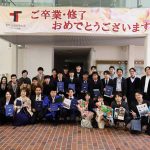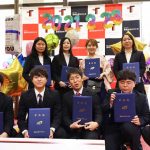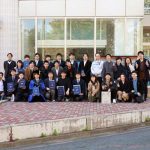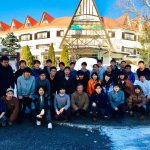Information
Mr. Hideo Doi (D3) appeared on FM Toyohashi, a local FM radio station.
2021/06/19 InformationTopix
Mr. Hideo Doi appeared on FM Toyohashi, a local FM radio station.
In collaboration with the local FM radio station FM Toyohashi (84.3MHz), we broadcast the program “Tempaku no Shiro Gikadai” every Saturday evening after 5:00 p.m. to introduce the research and educational activities of our university to a wide audience.
In this program, Mr. Yoshio Watanabe, a popular personality of FM Toyohashi, visits various laboratories and circles in our university and talks about the “What? Why? Why? in an easy-to-understand manner.
The program will be broadcast on Saturday, June 19, 2021, after 5:00 p.m. as follows
Speaker: Hideo Doi, 3rd year doctoral course student, Department of Electrical, Electronics and Information Engineering
Title: To ward Physiological Applications of Ion Image Sensor Technology
Broadcasting station: FM Toyohashi (84.3MHz)
Broadcast time: Saturday evenings from after 5:00 p.m.
Program name: “Tenhaku no Shiro Gikadai” (in “84 no 3 (Yashi no Mi) Wave THE BURRN”)
Graduate and Undergraduate Graduation Ceremonies for FY2020 were held.
2021/03/23 EventsInformationTopix
Graduate and Undergraduate Graduation Ceremonies for FY2020 were held.I look forward to the future activities of those who have graduated.
The 1st OPERA-RA Seminar
2020/10/22 InformationTopix
The JST OPERA Industry-Academia Collaboration Platform Joint Research Program is promoting the “Creation of multimodal sensing technology to visualize physical and chemical information at the micron level”. In this program, doctoral students are participating in joint research with companies as RAs. D3 Mr. Takahashi gave a lecture at the 1st RA seminar.
JST OPERA Multimodal Sensing Co-Creation Consortium held the 1st RA Seminar
Speaker:
Graduate School of Engineering, Toyohashi University of Technology
Department of Electrical, Electronic and Computer Engineering
Mr. Toshiaki Takahashi
Title: Development of MEMS Optical Interference Surface Stress Sensor to Detect Arbitrary Biomolecules with High Sensitivity
Date & Time: October 22, 2020 (Thursday) 12:30-13:00 (ZOOM)
The 2019 Graduate School Graduation and Undergraduate Graduation Ceremonies were held.
2020/03/23 InformationTopix
This year, in consideration of the spread of the COVID‑19, the ceremony was held on campus with a small number of graduates of the doctoral course, representatives of each department, and representatives of each course.
Visit from Deputy Director-General of the Minister’s Secretariat, Ministry of Economy, Trade and Industry (in charge of Industrial Science and Technology Policy and Environment Bureau)
2020/03/12 InformationTopix
2020/3/12 Mr. Watanabe, Deputy Director-General, Industrial Science and Technology Policy and Environment Bureau, Ministry of Economy, Trade and Industry, and Mr. Baba, Office for Promotion of University Collaboration, Technology Promotion and University Collaboration Promotion Division, Industrial Science and Technology Policy and Environment Bureau, visited our group and observed our research.
Mr. Fumitaka Endo (B4) won the IEEJ Tokai Section Chief Award.
2020/03/01 AwardsInformation
2020/3/1 Mr. Fumitaka Endo won the IEEJ Tokai Branch Award.
Title: Fabrication of Stretchable Plasmonic Nanosheets
A paper on in-vivo sensors has been published by Nature Communications.
2020/02/06 InformationpublicationTopix
2020/2/6 A paper on in-vivo sensors has been published by Nature Communications. This work was supported by the Japan Science and Technology Agency (JST) under the Core Research for Evolutional Science and Technology (CREST) program.
- “CMOS-based bio-image sensor spatially resolves neural activity dependent proton dynamics in the living brain”
- 著者名:Hiroshi Horiuchi, Masakazu Agetsuma, Junko Ishida, Yusuke Nakamura, Dennis Lawrence Cheung, Shin Nanasaki, Yasuyuki Kimura, Tatsuya Iwata, Kazuhiro Takahashi, Kazuaki Sawada, Junichi Nabekura
- DOI:10.1038/s41467-020-14571-y
◎We developed a thin CMOS ion image sensor that can be applied to living organisms, and succeeded in visualizing pH in the brain.We succeeded in visualizing pH in the brain by developing a thin CMOS ion image sensor that can be applied to living organisms.
◎We were able to detect dynamic changes in pH in the brain in response to visual stimuli.
| Abnormal pH (hydrogen ion concentration) has been observed in brain pathologies such as cerebral ischemia and epilepsy, and ultra-high resolution measurement of pH in the brain of living organisms may lead to the elucidation of new disease mechanisms and treatment methods. Hiroshi Horiuchi, Assistant Professor and Junichi Nabekura, Director of the Institute of Physiology, National Institutes of Natural Sciences, and Kazuaki Sawada, Professor of Toyohashi University of Technology, have developed a high-definition pH imaging tool that can be applied to living organisms. By visualizing brain pH in real time, they have succeeded for the first time in the world in capturing the dynamic changes in pH in the microenvironment as a result of neural activity. By applying this technique to future pathological research, it is expected to elucidate the mechanism of diseases.
The results of this research were published in the British scientific journal Nature Communications on February 5, 2020 (UK time). |
Alumnus had a farewell party for Prof. Dr. Iwata
2019/03/02 Information
2019/3/2
Alumni, graduated between 2015~2018, has a farewell party for Prof. Dr. Iwata.
2018 Farewell party for M2 and Prof. Dr. Iwata
2019/02/28 EventsInformation
2019/2/28 We had 2018 farewell party for M2 and Prof. Dr. Iwata.
Prof. Dr. Iwata will become a lecturer at Toyama Prefectural University from April, 2019.
The14th Ski trip (Hakuba valley)
2019/02/04 EventsInformation
2019/2/2-3 We had been to Hakuba valley for skiing.
Our group have been going to the ski trip every year, this year it is the 14th.
We were not only enjoying the skiing and snowboard, but also meeting with students, alumni and professors.















































